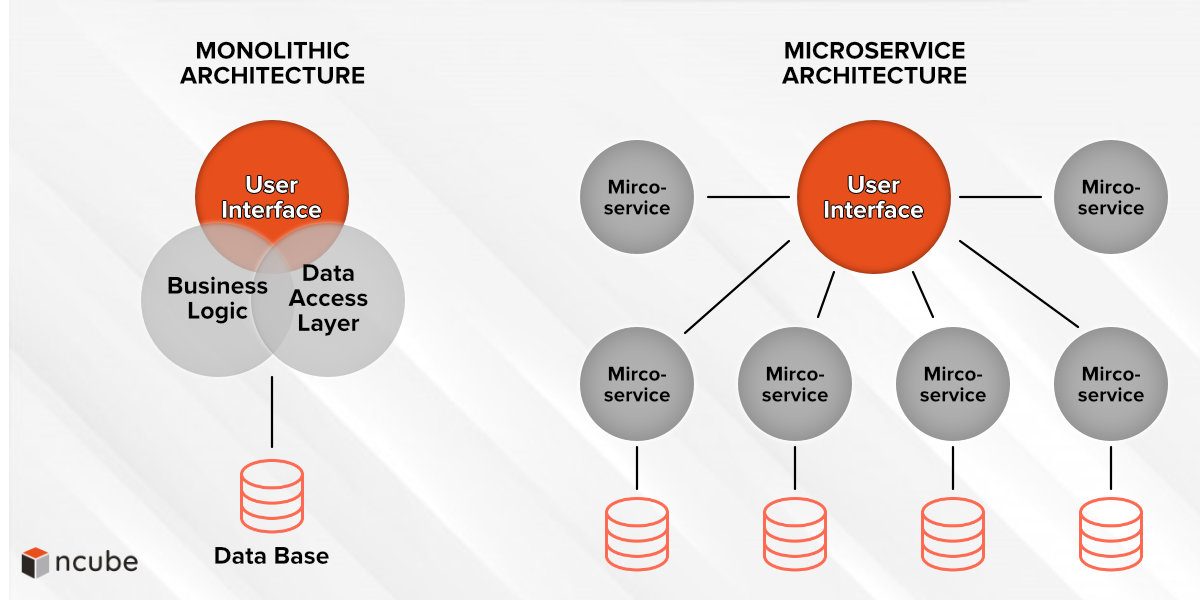
Microservices vs. Monolithic: Which Architecture Suits Best for Your Project?

How to organize code is the first thing that comes to mind when creating a new product. In this context, you’ve probably heard of the monolithic vs. microservice architecture debate. While monolith apps have been around for a long time, microservices are considered to be a relatively novel way of designing a software system. In fact, a whole range of technologies appeared within the philosophy of DevOps that brought us the ability to build scalable, distributed solutions based on microservices. In this article, we will look closely at these two approaches so you can pick out one that is right for your needs.
What is a monolithic architecture?
It’s a traditional approach to software development in which the entire system function is based on a single application as a single, autonomous unit. A helpful analogy here would be a large block of stone (a.k.a monolith). In software development, this single block would stand for a single platform.
In a monolithic app, all functions are managed and served in one place. Of course, an app has its inner structure consisting of a database, client-side interface, business logic, but it still remains an indivisible unit. Its components don’t require API to communicate.
Advantages of monolithic applications
- Monolithic architecture is easier to implement, while microservices require much more effort. It’s simpler to implement business logic without worrying about the orchestration of the components.
- Monolithic apps have higher performance than microservice apps because they don’t involve API for communication between components.
- As a single unit, a monolithic app is easier to debug and test since you can do automated testing without considering different run-time environments as with microservices.
- Deployment is very simple. It’s down to using a script that loads your module and launches the application.
- There are much less cross-cutting concerns like login, caching, memory management, and other with one application in place.
Disadvantages of monolithic applications
- Tight coupling. Monolithic applications are characterized by tightly coupling processes, so their code base tends to become convoluted as it grows, so it becomes harder to isolate services for independent scaling and code support.
- Low flexibility. Each element is dependent on the others, so any change affects the whole network. As such, changes are time-consuming and need to be carefully coordinated. Also, each small update comes with redeployment.
- Scaling confines. Monolith apps can only scale as a whole. Scaling components individually is impossible.
What is a microservice software architecture?
In a microservice architecture, business logic is broken down into lightweight, single-purpose self-sufficient services. As such, the infrastructure is akin to collection modules. Each service within this type of architecture is responsible for a specific business goal. In essence, the microservice architecture looks like a Lego construction, which can be decomposed into a number of modules. The interaction between the components of the system ensured by means of API.

Advantages of microservices architecture
- Autonomy. You can build cross-functional, independent teams for each business goal. The features they deploy won’t affect other services.
- Agility. Microservices let you select and use different languages and storage technologies for different functions. To top it off, microservices can function on any device, both in Cloud and on-premise.
- Scalability. As opposed to monolith architecture, you don’t need to scale the entire system – it’s enough to alter only one element of the system.
- High reliability. Because microservices are autonomous, a failure or damage in one module don’t affect others.
- Modules are reusable and can be reprofiled for other tasks.
- Continuous delivery is made simple. You can work on specific elements of the system without disrupting the whole system.
Disadvantages of microservices architecture
- Designing distributed systems can be challenging. A great deal of effort goes into designing the connections inside the distributed system.
- Microservice architecture requires more resources and usually takes more time than monolithic architecture.
- There are more Cross-Cutting Concerns with microservices – logging, caching needs to be taken care of in every service.
- Complex deployment. The number of elements increases its operational complexity. Thus, deployment becomes harder because developers need to manage numerous autonomous services and interactions between them.
- The more complex the structure is, the more difficult testing will be. In particular, testing of the interactions between the services.
Monolithic vs microservice architecture compared
| Monolithic architecture | Microservice architecture | |
| Deployment | deploy an entire system once, adjust as needed | possibility to deploy (and rollback) each microservice individually |
| Maintenance | .NET, Java, PHP, or Ruby, Python/Django skills are required | DevOps, Docker, Kubernetes, Lambda, etc skills are required |
| Reliability | one failure may cause the whole system to go down | a failure of one service doesn’t affect other services |
| Scalability | low, only vertical | high |
| Agility | impossible to implement new technologies, programming languages | possibility to use different languages, technologies for different business needs |
| Development | teams are involved in the development process simultaneously | different teams can work on different elements of the solution |
| Updates | updates might take a while because of internal dependencies within the architecture and other developers working at the same time | fast updates due to the minimalistic nature of modules due to the autonomous nature of services |
| Testing | possibility of end-to-end testing | each component needs to be tested individually |
| Security | secure data processing and transferring is easier at the system level | communication between services via API gateway raises security issues |
When to go with a monolithic architecture?
In some cases, a monolithic approach is a time-tested strategy:
- you plan to build a small app.
- you don’t plan to grow your team. In this case, designing and managing a complex system is not the best way to go.
- you’re at the ideation stage. If you are at the first stage of SDLC, your product is likely to grow over time. A monolithic architecture allows for fast iterating.
- you are building an MVP. At this stage, your goal is to gather feedback from first users as soon as possible and monolith apps are the quickest way.
When to go with microservices?
Plenty of companies switched to the microservice architecture after their customer demand increased significantly. Among them are Amazon, PayPal, Spotify, and many more.
- you want to build a large-scale solution.
- you have a lot of time on your hands since microservice architecture requires thorough planning.
- scalability is critical for your project and you plan to grow your development team.
- you need to use different languages for different elements like C++ for backend and Rails for the user interface.
- You want to build multiple independent teams that would work on different functions of your solution.
Read also: TOP PYTHON WEB FRAMEWORKS
Afterword
When the tradeoff boils down to these types of architecture, consider your organizational structure. If you have several teams that will work on one product, microservices would be a good fit. On the other hand, the team of three developers is better suited for monolithic architecture.
Other important factors are the agility and complexity of the project. A fast-paced project with complex business logic fits in well with the microservice concept.
But if you are unfamiliar with microservices, consider a monolithic approach with a modular structure. When your solution grows, a modular structure will let you decompose an app easily.
Recommended articles


